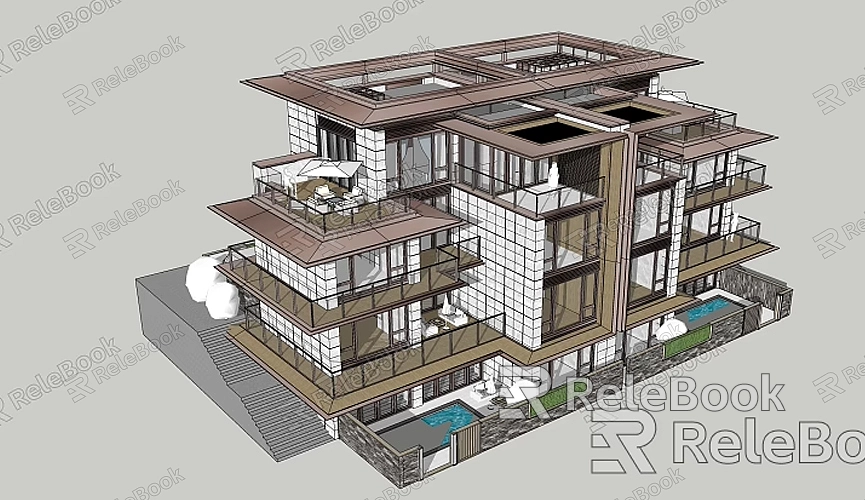How to import sketchup model into layout
For many designers and architects, SketchUp is a very popular 3D modeling tool. It's used for creating precise architectural models, interior designs, landscaping, and more, all with an intuitive and easy-to-use interface. However, SketchUp itself doesn't have the ability to directly generate high-quality 2D documents or construction drawings. This is where LayOut, a part of the SketchUp suite, becomes extremely important. LayOut allows users to transform SketchUp models into high-quality 2D drawings, presentations, and construction documents.
After modeling in SketchUp, importing the model into LayOut not only helps create drawings more efficiently but also maintains a real-time connection with the model. This means that if any changes are made to the model in SketchUp, the corresponding views in LayOut will automatically update. This article will guide you on how to import SketchUp models into LayOut and provide some tips to help you use this tool to create professional design documents.

Why Use LayOut for Creating 2D Drawings from SketchUp Models?
Before discussing how to import SketchUp models into LayOut, it’s important to understand why LayOut is the go-to tool for creating 2D documents.
Simplified Document Creation
LayOut allows users to quickly generate floor plans, section views, elevations, and more from a SketchUp 3D model. With LayOut, you can present your model from multiple angles and create construction drawings that meet architectural standards through views, annotations, and dimensioning.
Real-Time Updates
LayOut is closely integrated with SketchUp, allowing you to update files in real time when the model changes. If you modify part of the model in SketchUp, the view in LayOut will automatically update. This dynamic updating feature greatly enhances work efficiency, eliminating the need to manually redraw or update drawings.
Accurate Scaling and Dimensions
LayOut ensures accurate scaling and dimensions, whether you're preparing conceptual designs or detailed construction documents. You can set different scale ratios to ensure the drawings match actual measurements.
Versatile Output Formats
LayOut allows you to export files as PDFs, images (PNG, JPG, TIFF, etc.), or print directly, making it easy to share and present your work. When providing electronic documents, PDFs exported from LayOut usually retain all model details and the layout of the drawings, making them easy to share and print.
Preparing for Import: Optimize Your SketchUp Model
Before importing a SketchUp model into LayOut, it’s a good idea to do some preparation. Optimizing the model not only ensures a smoother import process but also reduces the chance of errors. Here are some common preparation steps:
Clean Up the Model
SketchUp models often contain unnecessary elements, such as unused components, materials, and layers. Before importing into LayOut, it’s best to clean up the model. This not only reduces file size but also improves the operation speed in LayOut. Use SketchUp’s "Cleanup" tool to remove unused components and materials.

Organize Layers and Scenes
Scenes and layers are important in SketchUp for creating different views and display settings. Before importing into LayOut, make sure you’ve created appropriate scenes for each view and used layers effectively to control the visibility of different objects. This will help you quickly select the views you need in LayOut without needing to adjust them repeatedly.
Check Units and Scale
Since LayOut and SketchUp use the same units, it’s crucial that your SketchUp model uses the correct units. You can set units in SketchUp’s "Model Info" and choose between metric or imperial units. This ensures the dimensions are consistent when imported into LayOut, and the scale remains accurate.
Importing a SketchUp Model into LayOut
Once your SketchUp model is ready, you can start importing it into LayOut. The import process is straightforward and requires little effort.
Open LayOut and Create a New File
First, open LayOut and create a new file. If you already have a LayOut file, just open it. If not, you can choose a template that fits your design needs.
Insert the SketchUp Model
In LayOut’s top menu, select "File" and click "Insert." In the dialog box that pops up, choose the SketchUp file (.skp) you want to import and click "Open."
Adjust the Position and Scale of the Model
Once imported, the SketchUp model will automatically be inserted into LayOut as a viewport. You can drag the model to adjust its position and scale it to fit the drawing page as needed. LayOut allows you to freely adjust the size of the viewport to display different views or details.
Setting Up Viewports and Views
LayOut’s viewports allow you to display different views, scales, and styles. You can independently adjust each viewport to ensure that every drawing accurately represents the required view.
Choose the Right View
In LayOut, click on the viewport and right-click to select "Update/Select Scene." Then choose the scene you saved in SketchUp. This allows you to easily import any view from SketchUp into LayOut while maintaining consistency.
Set the Display Style
LayOut lets you choose different display styles, including "Wireframe," "Shaded," and "Hidden Line." Depending on the need, you can choose different styles for each viewport. For example, you might want to display floor plans in "Hidden Line" mode, while elevation views use "Shaded" mode.
Adjust the Viewport Scale
You can adjust the viewport scale to match the drawing paper's scale. In LayOut, right-click on the viewport, select "Viewport Settings," and adjust the scale. Here, you can also set cutting planes and camera angles.
Maintaining Real-Time Updates with the SketchUp Model
When you make changes to the model in SketchUp, these changes will automatically sync to LayOut, provided that you’ve saved the SketchUp file and updated the LayOut viewport. Updating is simple—just right-click on the viewport in LayOut and choose "Update Model Reference," and LayOut will load the latest changes made in SketchUp.
This real-time syncing feature makes it easy to switch between SketchUp and LayOut without worrying about missing important updates.
Exporting and Sharing
After completing the drawings, LayOut provides several export options. You can export the drawings as a PDF or save them as image files (e.g., PNG or JPG) for sharing. If you need to print, you can do so directly from LayOut, ensuring the drawings are presented at the correct size and scale.
Tips
- Use Templates Wisely: LayOut offers multiple template options to help you quickly create standard architectural drawings. Using templates can significantly improve efficiency.
- Organize Views and Layers: In LayOut, use layers to manage the visibility of different views and ensure each view is clear and legible.
- Add Dimensions and Annotations: With LayOut’s dimensioning tools, you can easily add dimensions, notes, and annotations to help communicate design details.
Importing a SketchUp model into LayOut is a crucial step for quickly creating beautiful 2D drawings and construction documents from your 3D model. The powerful features of LayOut ensure that you can stay efficient throughout the design process and maintain the accuracy and consistency of your design documents. Moreover, the real-time updating feature between SketchUp and LayOut ensures that design changes are instantly reflected in the files, reducing the chances of errors or manual updates.
If you need high-quality 3D textures or HDRI for creating models and virtual scenes, you can download them for free from [Relebook Textures](https://textures.relebook.com/). For premium 3D models, visit [Relebook Models](https://3dmodels.relebook.com/). Relebook offers a large collection of top-quality 3D resources to help elevate your design quality and create more detailed and realistic 3D models.
Overall, for architects, designers, and engineers, mastering how to import a SketchUp model into LayOut and using it effectively is a key step in improving work efficiency and producing high-quality design drawings.

